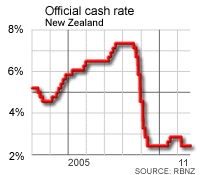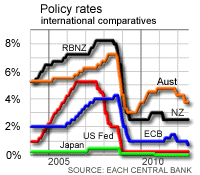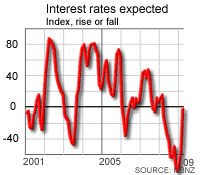 By ASB Chief Economist Nick Tuffley Unquestionably the NZ economic outlook has deteriorated further, largely due to external forces. The global economic outlook is rapidly unravelling, with US data disappointing and now China and Australia starting to slip. NZ's export-led recovery is now looking increasingly fragile. In addition, international dairy prices have fallen rapidly and Fonterra's payout has been revised down. Consequently, views on the outlook for rural incomes and land prices have sobered up considerably. Global markets remain skittish and there has been little progress made in getting wholesale funding markets back into operation. When making its decision, the RBNZ also needs to make an assumption on how effective domestic and international efforts will be to combat the global credit crisis and its far-reaching economic
By ASB Chief Economist Nick Tuffley Unquestionably the NZ economic outlook has deteriorated further, largely due to external forces. The global economic outlook is rapidly unravelling, with US data disappointing and now China and Australia starting to slip. NZ's export-led recovery is now looking increasingly fragile. In addition, international dairy prices have fallen rapidly and Fonterra's payout has been revised down. Consequently, views on the outlook for rural incomes and land prices have sobered up considerably. Global markets remain skittish and there has been little progress made in getting wholesale funding markets back into operation. When making its decision, the RBNZ also needs to make an assumption on how effective domestic and international efforts will be to combat the global credit crisis and its far-reaching economic  impact. Judging from the Financial Stability Report, the RBNZ remains fairly optimistic that the NZ financial system remains sound and that funding guarantees should be effective, although does concede negative impacts on growth will occur. The RBNZ has to weigh these negative developments against the good news for the economy, namely: lower mortgage rates; lower petrol prices; tax cuts and the lower NZ dollar. Further fiscal expansion looms. There is a significant amount of stimulus that is set to work its way through to help cushion the externally-driven slowdown. However, one key offset which might keep consumer spending weak is an increased saving rate as economic and employment uncertainty rise.
impact. Judging from the Financial Stability Report, the RBNZ remains fairly optimistic that the NZ financial system remains sound and that funding guarantees should be effective, although does concede negative impacts on growth will occur. The RBNZ has to weigh these negative developments against the good news for the economy, namely: lower mortgage rates; lower petrol prices; tax cuts and the lower NZ dollar. Further fiscal expansion looms. There is a significant amount of stimulus that is set to work its way through to help cushion the externally-driven slowdown. However, one key offset which might keep consumer spending weak is an increased saving rate as economic and employment uncertainty rise.
Tactical considerations will likely have a big influence on the final decision. Market pricing has moved to 140bp and forecasters are increasingly touting 150bp. Is the RBNZ comfortable with the market effectively dictating OCR moves, or does the RBNZ judge that the market is getting too ahead of itself? There are 3 scenarios that could play out:
- The RBNZ cuts by 150bp, concurring implicitly with the market view that the global economy and impact on NZ will be so severe that rapid action is necessary "“ and likely to be aggressively followed up;
- The RBNZ cuts by 150bp, grudgingly pushed to that point by an unwillingness to underwhelm market expectations;
- The RBNZ cuts by 100bp or 125bp, viewing that market expectations have moved further than is warranted at this time.
 In working out what to do the RBNZ has to start thinking about where the easing cycle could potentially finish. If at this stage it believes the economic situation is bleak enough that the OCR could conceivably drop below 4% then it would be more prepared to cut by 150bp. It wouldn't be concerned about galvanising the markets to price in an even lower end point than the 3.75% currently built in as it would be confident interest rates will be markedly lower again before long. Such a cut would also be accompanied by a very dovish statement. However, if the RBNZ is expecting the OCR to finish at or above 4% then it needs to think harder about whether it wants to risk fuelling market expectations or wants to temper the considerable amount of easing built into the market. The Reserve Bank of Australia just had to make a similar decision, and chose to cut interest rates 100bp, slightly more than the median market forecast but "“ crucially "“ less than the markets had priced in, causing markets to sell off considerably and pare back future rate cut expectations. A message from the move is that central banks are prepared to set a slower pace than what is priced in. Implications: could the RBNZ slightly underwhelm? As Thursday's meeting has got closer, speculation of a 150bp cut has intensified. Market participants and forecasters are gradually converging on that figure in the manner of a self-fulfilling prophesy.
In working out what to do the RBNZ has to start thinking about where the easing cycle could potentially finish. If at this stage it believes the economic situation is bleak enough that the OCR could conceivably drop below 4% then it would be more prepared to cut by 150bp. It wouldn't be concerned about galvanising the markets to price in an even lower end point than the 3.75% currently built in as it would be confident interest rates will be markedly lower again before long. Such a cut would also be accompanied by a very dovish statement. However, if the RBNZ is expecting the OCR to finish at or above 4% then it needs to think harder about whether it wants to risk fuelling market expectations or wants to temper the considerable amount of easing built into the market. The Reserve Bank of Australia just had to make a similar decision, and chose to cut interest rates 100bp, slightly more than the median market forecast but "“ crucially "“ less than the markets had priced in, causing markets to sell off considerably and pare back future rate cut expectations. A message from the move is that central banks are prepared to set a slower pace than what is priced in. Implications: could the RBNZ slightly underwhelm? As Thursday's meeting has got closer, speculation of a 150bp cut has intensified. Market participants and forecasters are gradually converging on that figure in the manner of a self-fulfilling prophesy.  Be it 100bp, 125bp, 150bp "“ or even 200bp "“ the size of potential OCR cuts is getting quite arbitrary. A case can be made for virtually any 3-digit number, such is the lack of any strong anchor. If the RBNZ is likely to get to around 4% (or even lower), why not get there right now and cut by at least 200bp (after all, the RBNZ has been doubling the size of cuts at successive meetings)? How long is a piece of string? On Thursday the RBNZ may well choose the path of least resistance and cut by 150bp: regardless of whether it believes that number is warranted or not because that is where expectations are centred. Given the easing cycle is unlikely to be at the bottom quite yet, there is little to lose in getting there fast. The RBNZ hasn't shied away from bold moves in the recent past, and has not yet had a reason to regret them. Nevertheless, we do have a nagging doubt that the RBNZ may not go quite as far as expectations have been drifting, if only because there will rapidly become a limit to how long the RBNZ will be prepared to make outsized cuts. But, given the extent of market pricing, a cut of "˜only' 100bp would be a very disruptive way of signalling to the market to think a bit harder about the future pace of the OCR. For that reason we float the possibility that the RBNZ cuts by 125bp. A cut of such a size would send the message that considered thought needs to go into the future path of the OCR but do it in such a way that there is little disruption to financial markets.
Be it 100bp, 125bp, 150bp "“ or even 200bp "“ the size of potential OCR cuts is getting quite arbitrary. A case can be made for virtually any 3-digit number, such is the lack of any strong anchor. If the RBNZ is likely to get to around 4% (or even lower), why not get there right now and cut by at least 200bp (after all, the RBNZ has been doubling the size of cuts at successive meetings)? How long is a piece of string? On Thursday the RBNZ may well choose the path of least resistance and cut by 150bp: regardless of whether it believes that number is warranted or not because that is where expectations are centred. Given the easing cycle is unlikely to be at the bottom quite yet, there is little to lose in getting there fast. The RBNZ hasn't shied away from bold moves in the recent past, and has not yet had a reason to regret them. Nevertheless, we do have a nagging doubt that the RBNZ may not go quite as far as expectations have been drifting, if only because there will rapidly become a limit to how long the RBNZ will be prepared to make outsized cuts. But, given the extent of market pricing, a cut of "˜only' 100bp would be a very disruptive way of signalling to the market to think a bit harder about the future pace of the OCR. For that reason we float the possibility that the RBNZ cuts by 125bp. A cut of such a size would send the message that considered thought needs to go into the future path of the OCR but do it in such a way that there is little disruption to financial markets.
We welcome your comments below. If you are not already registered, please register to comment.
Remember we welcome robust, respectful and insightful debate. We don't welcome abusive or defamatory comments and will de-register those repeatedly making such comments. Our current comment policy is here.